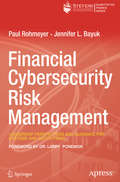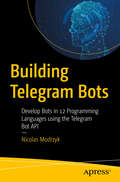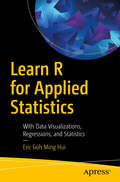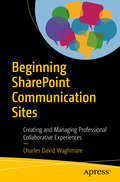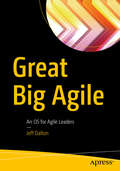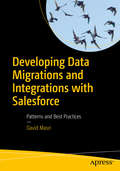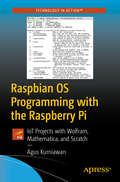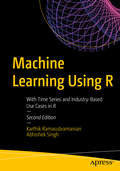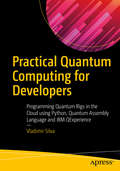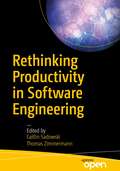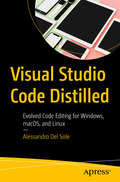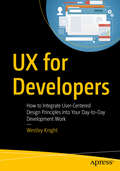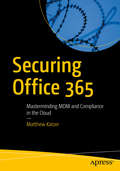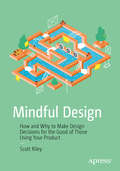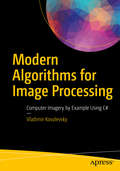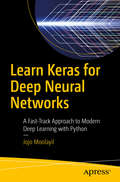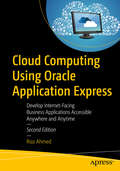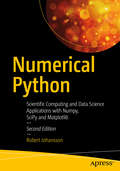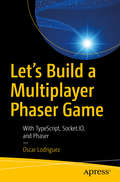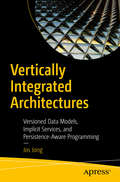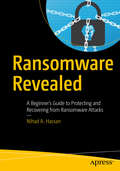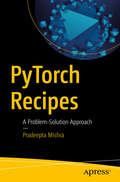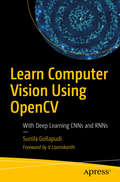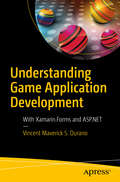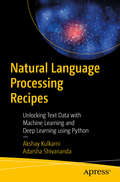- Table View
- List View
Financial Cybersecurity Risk Management: Leadership Perspectives and Guidance for Systems and Institutions
by Paul Rohmeyer Jennifer L. BayukUnderstand critical cybersecurity and risk perspectives, insights, and tools for the leaders of complex financial systems and markets. This book offers guidance for decision makers and helps establish a framework for communication between cyber leaders and front-line professionals. Information is provided to help in the analysis of cyber challenges and choosing between risk treatment options.Financial cybersecurity is a complex, systemic risk challenge that includes technological and operational elements. The interconnectedness of financial systems and markets creates dynamic, high-risk environments where organizational security is greatly impacted by the level of security effectiveness of partners, counterparties, and other external organizations. The result is a high-risk environment with a growing need for cooperation between enterprises that are otherwise direct competitors. There is a new normal of continuous attack pressures that produce unprecedented enterprise threats that must be met with an array of countermeasures. Financial Cybersecurity Risk Management explores a range of cybersecurity topics impacting financial enterprises. This includes the threat and vulnerability landscape confronting the financial sector, risk assessment practices and methodologies, and cybersecurity data analytics. Governance perspectives, including executive and board considerations, are analyzed as are the appropriate control measures and executive risk reporting.What You’ll LearnAnalyze the threat and vulnerability landscape confronting the financial sectorImplement effective technology risk assessment practices and methodologiesCraft strategies to treat observed risks in financial systemsImprove the effectiveness of enterprise cybersecurity capabilitiesEvaluate critical aspects of cybersecurity governance, including executive and board oversightIdentify significant cybersecurity operational challengesConsider the impact of the cybersecurity mission across the enterpriseLeverage cybersecurity regulatory and industry standards to help manage financial services risksUse cybersecurity scenarios to measure systemic risks in financial systems environmentsApply key experiences from actual cybersecurity events to develop more robust cybersecurity architecturesWho This Book Is For Decision makers, cyber leaders, and front-line professionals, including: chief risk officers, operational risk officers, chief information security officers, chief security officers, chief information officers, enterprise risk managers, cybersecurity operations directors, technology and cybersecurity risk analysts, cybersecurity architects and engineers, and compliance officers
Building Telegram Bots: Develop Bots in 12 Programming Languages using the Telegram Bot API
by Nicolas ModrzykLearn about bot programming, using all the latest and greatest programming languages, including Python, Go, and Clojure, so you can feel at ease writing your Telegram bot in a way that suits you.This book shows how you can use bots for just about everything: they connect, they respond, they enhance your job search chances, they do technical research for you, they remind you about your last train, they tell the difference between a horse and a zebra, they can tell jokes, and they can cheer you up in the middle of the night. Bots used to be hard to set up and enhance, but with the help of Building Telegram Bots you’ll see how the Telegram platform is now making bot creation easier than ever. You will begin by writing a simple bot at the start and then gradually build upon it. The simple yet effective Telegram Bot API makes it very easy to develop bots in a number of programming languages. Languages featured in the book include Node.js, Java, Rust, and Elixir. This book encourages you to not only learn the basic process of creating a bot but also lets you spend time exploring its possibilities. By the end of the book you will be able create your own Telegram Bot with the programming language of your choice. What You Will LearnCarry out simple bot design and deployment in various programming languages including Ruby, D, Crystal, Nim, and C++Create engaging bot interactions with your usersAdd payments and media capabilities to your botsMaster programming language abstractionWho This Book Is ForEngineers who want to get things done. People who are curious. Programming beginners. Advanced engineers with little time to do research.
Learn R for Applied Statistics: With Data Visualizations, Regressions, and Statistics
by Eric Goh HuiGain the R programming language fundamentals for doing the applied statistics useful for data exploration and analysis in data science and data mining. This book covers topics ranging from R syntax basics, descriptive statistics, and data visualizations to inferential statistics and regressions. After learning R’s syntax, you will work through data visualizations such as histograms and boxplot charting, descriptive statistics, and inferential statistics such as t-test, chi-square test, ANOVA, non-parametric test, and linear regressions. Learn R for Applied Statistics is a timely skills-migration book that equips you with the R programming fundamentals and introduces you to applied statistics for data explorations. What You Will LearnDiscover R, statistics, data science, data mining, and big dataMaster the fundamentals of R programming, including variables and arithmetic, vectors, lists, data frames, conditional statements, loops, and functionsWork with descriptive statistics Create data visualizations, including bar charts, line charts, scatter plots, boxplots, histograms, and scatterplotsUse inferential statistics including t-tests, chi-square tests, ANOVA, non-parametric tests, linear regressions, and multiple linear regressionsWho This Book Is ForThose who are interested in data science, in particular data exploration using applied statistics, and the use of R programming for data visualizations.
Beginning SharePoint Communication Sites
by Charles David WaghmareUnderstand SharePoint communication sites and create one on your own using SharePoint Home available in Office 365. This beginner's book will advise you about the ways to integrate your existing collaboration channels with SharePoint communication sites. Along the way you will see how to embed documents, videos, and real-time data from across Office 365, including documents from SharePoint, Power BI reports, Microsoft Stream videos, and Yammer discussions. The author starts by giving an introduction to SharePoint communication sites and how to create them. Next, you’ll cover various cases to understand the benefits of communicating through SharePoint communications sites. Further, you will learn how to design collaborative experiences for end users along with ways to plan social intranets. Here, you will understand how to integrate Yammer, SharePoint Online and email in order to build a collaborative experience. You will then integrate communication sites with Office 365 products for better end user collaboration. Finally, you will discover how to plan for and create communities using communication sites and learn more about social knowledge management.After reading Beginning SharePoint Communication Sites, you will be able to create and manage SharePoint communication sites and improve ways to communicate and collaborate within your organization. What You Will LearnCreate SharePoint communication sites to share information with larger and smaller groupsEnrich the end-user experience while sharing information with a bigger audience Plan digital intranets using SharePoint communication sitesDesign visually compelling intranetsTransform the way you share information within your companyDynamically pull in and display data, documents, and information via web partsIntegrate with Yammer and emails to create collaborative user experiencesWho This Book Is ForIT workers who use SharePoint and are involved in internal communication management, evangelism, digital transformation, social media, and intranet design.
Great Big Agile: An OS for Agile Leaders
by Jeff DaltonBig Agile leaders need an empirical, "high-trust" model that provides guidance for scaling and sustaining agility and capability throughout a modern technology organization. This book presents the Agile Performance Holarchy (APH)—a "how-ability" model that provides agile leaders and teams with an operating system to build, evaluate, and sustain great agile habits and behaviors. The APH is an organizational operating system based on a set of interdependent, self-organizing circles, or holons, that reflect the empirical, object-oriented nature of agility. As more companies seek the benefits of Agile within and beyond IT, agile leaders need to build and sustain capability while scaling agility—no easy task—and they need to succeed without introducing unnecessary process and overhead. The APH is drawn from lessons learned while observing and assessing hundreds of agile companies and teams. It is not a process or a hierarchy, but a holarchy, a series of performance circles with embedded and interdependent holons that reflect the behaviors of high-performing agile organizations. Great Big Agile provides implementation guidance in the areas of leadership, values, teaming, visioning, governing, building, supporting, and engaging within an all-agile organization. What You’ll Learn Model the behaviors of a high-performance agile organizationBenefit from lessons learned by other organizations that have succeeded with Big AgileAssess your level of agility with the Agile Performance HolarchyApply the APH model to your businessUnderstand the APH performance circles, holons, objectives, and actionsObtain certification for your company, organization, or agency Who This Book Is For Professionals leading, or seeking to lead, an agile organization who wish to use an innovative model to raise their organization's agile performance from one level to the next, all the way to mastery
Developing Data Migrations and Integrations with Salesforce: Patterns And Best Practices
by David MasriMigrate your data to Salesforce and build low-maintenance and high-performing data integrations to get the most out of Salesforce and make it a "go-to" place for all your organization's customer information.When companies choose to roll out Salesforce, users expect it to be the place to find any and all Information related to a customer—the coveted Client 360° view. On the day you go live, users expect to see all their accounts, contacts, and historical data in the system. They also expect that data entered in other systems will be exposed in Salesforce automatically and in a timely manner. This book shows you how to migrate all your legacy data to Salesforce and then design integrations to your organization's mission-critical systems. As the Salesforce platform grows more powerful, it also grows in complexity. Whether you are migrating data to Salesforce, or integrating with Salesforce, it is important to understand how these complexities need to be reflected in your design. Developing Data Migrations and Integrations with Salesforce covers everything you need to know to migrate your data to Salesforce the right way, and how to design low-maintenance, high-performing data integrations with Salesforce. This book is written by a practicing Salesforce integration architect with dozens of Salesforce projects under his belt. The patterns and practices covered in this book are the results of the lessons learned during those projects. What You’ll LearnKnow how Salesforce’s data engine is architected and whyUse the Salesforce Data APIs to load and extract dataPlan and execute your data migration to SalesforceDesign low-maintenance, high-performing data integrations with SalesforceUnderstand common data integration patterns and the pros and cons of eachKnow real-time integration options for SalesforceBe aware of common pitfallsBuild reusable transformation code covering commonly needed Salesforce transformation patternsWho This Book Is For Those tasked with migrating data to Salesforce or building ongoing data integrations with Salesforce, regardless of the ETL tool or middleware chosen; project sponsors or managers nervous about data tracks putting their projects at risk; aspiring Salesforce integration and/or migration specialists; Salesforce developers or architects looking to expand their skills and take on new challenges
Raspbian OS Programming with the Raspberry Pi: IoT Projects with Wolfram, Mathematica, and Scratch
by Agus KurniawanMaster the command line and Raspbian Linux as well as the physical connections of the Pi. With this book you’ll develop skills applicable to other real world applications in both hardware and software development all while working on simple and fun IoT projects that you can do yourself.You'll learn to build programs on the top of Raspbian OS in Raspberry Pi boards. Start by using Raspbian shells to develop programs.Then follow projects and samples step-by-step to get new experiences in Raspbian OS development. You'll also learn the Wolfram Language and Mathematica, Scratch, IoT programs and IoT middleware, Node-RED, Interactive Data Visualization with Jupyter Notebook, and more.There are many features in Raspbian OS and on Raspberry Pi boards perfect for building an IoT program to suite various scenarios. The GPIO pins on your Raspberry Pi allow it to scale further to accomplish all kinds of projects and tasks. Raspbian OS Programming with the Raspberry Pi is your pathway to exploring all of this.What You'll LearnDiscover the basics of programming in the Raspbian OS environment Work with the Raspbian Commandline Develop programs with the Wolfram Language and MathematicaWho This Book Is ForStudents and hobbyists interested in programming on Raspbian OS with Raspberry Pi boards.
Machine Learning Using R
by Karthik Ramasubramanian Abhishek SinghExamine the latest technological advancements in building a scalable machine-learning model with big data using R. This second edition shows you how to work with a machine-learning algorithm and use it to build a ML model from raw data. You will see how to use R programming with TensorFlow, thus avoiding the effort of learning Python if you are only comfortable with R.As in the first edition, the authors have kept the fine balance of theory and application of machine learning through various real-world use-cases which gives you a comprehensive collection of topics in machine learning. New chapters in this edition cover time series models and deep learning.What You'll Learn Understand machine learning algorithms using RMaster the process of building machine-learning models Cover the theoretical foundations of machine-learning algorithmsSee industry focused real-world use casesTackle time series modeling in RApply deep learning using Keras and TensorFlow in RWho This Book is ForData scientists, data science professionals, and researchers in academia who want to understand the nuances of machine-learning approaches/algorithms in practice using R.
Practical Quantum Computing for Developers: Programming Quantum Rigs In The Cloud Using Python, Quantum Assembly Language And Ibm Qexperience
by Vladimir SilvaWrite algorithms and program in the new field of quantum computing. This book covers major topics such as the physical components of a quantum computer: qubits, entanglement, logic gates, circuits, and how they differ from a traditional computer. Also, Practical Quantum Computing for Developers discusses quantum computing in the cloud using IBM Q Experience including: the composer, quantum scores, experiments, circuits, simulators, real quantum devices, and more. You’ll be able to run experiments in the cloud on a real quantum device.Furthermore, this book shows you how to do quantum programming using the QISKit (Quantum Information Software Kit), Python SDK, and other APIs such as QASM (Quantum Assembly). You’ll learn to write code using these languages and execute it against simulators (local or remote) or a real quantum computer provided by IBM’s Q Experience. Finally, you’ll learn the current quantum algorithms for entanglement, random number generation, linear search, integer factorization, and others. You’ll peak inside the inner workings of the Bell states for entanglement, Grover’s algorithm for linear search, Shor’s algorithm for integer factorization, and other algorithms in the fields of optimization, and more.Along the way you’ll also cover game theory with the Magic Square, an example of quantum pseudo-telepathy where parties sharing entangled states can be observed to have some kind of communication between them. In this game Alice and Bob play against a referee. Quantum mechanics allows Alice and Bob to always win!By the end of this book, you will understand how this emerging technology provides massive parallelism and significant computational speedups over classical computers, and will be prepared to program quantum computers which are expected to replace traditional computers in the data center.What You Will LearnUse the Q Experience Composer, the first-of-its-kind web console to create visual programs/experiments and submit them to a quantum simulator or real device on the cloudRun programs remotely using the Q Experience REST API Write algorithms that provide superior performance over their classical counterpartsBuild a Node.js REST client for authenticating, listing remote devices, querying information about quantum processors, and listing or running experiments remotely in the cloudCreate a quantum number generator: The quintessential coin flip with a quantum twistDiscover quantum teleportation: This algorithm demonstrates how the exact state of a qubit (quantum information) can be transmitted from one location to another, with the help of classical communication and quantum entanglement between the sender and receiverPeek into single qubit operations with the classic game of Battleships with a quantum twistHandle the counterfeit coin problem: a classic puzzle that consists of finding a counterfeit coin in a beam balance among eight coins in only two turnsWho This Book Is ForDevelopers and programmers interested in this new field of computing.
Rethinking Productivity in Software Engineering
by Thomas Zimmermann Caitlin SadowskiGet the most out of this foundational reference and improve the productivity of your software teams. This open access book collects the wisdom of the 2017 "Dagstuhl" seminar on productivity in software engineering, a meeting of community leaders, who came together with the goal of rethinking traditional definitions and measures of productivity.The results of their work, Rethinking Productivity in Software Engineering, includes chapters covering definitions and core concepts related to productivity, guidelines for measuring productivity in specific contexts, best practices and pitfalls, and theories and open questions on productivity. You'll benefit from the many short chapters, each offering a focused discussion on one aspect of productivity in software engineering.Readers in many fields and industries will benefit from their collected work. Developers wanting to improve their personal productivity, will learn effective strategies for overcoming common issues that interfere with progress. Organizations thinking about building internal programs for measuring productivity of programmers and teams will learn best practices from industry and researchers in measuring productivity. And researchers can leverage the conceptual frameworks and rich body of literature in the book to effectively pursue new research directions.What You'll LearnReview the definitions and dimensions of software productivitySee how time management is having the opposite of the intended effectDevelop valuable dashboardsUnderstand the impact of sensors on productivityAvoid software development wasteWork with human-centered methods to measure productivityLook at the intersection of neuroscience and productivityManage interruptions and context-switchingWho Book Is ForIndustry developers and those responsible for seminar-style courses that include a segment on software developer productivity. Chapters are written for a generalist audience, without excessive use of technical terminology.
Visual Studio Code Distilled: Evolved Code Editing for Windows, macOS, and Linux
by Alessandro Del SoleUse Visual Studio Code to write and debug code quickly and efficiently on any platform, for any device, using any programming language, and on the operating system of your choice. Visual Studio Code is an open source and cross-platform development tool that focuses on code editing across a variety of development scenarios, including web, mobile, and cloud development. Visual Studio Code Distilled teaches you how to be immediately productive with Visual Studio Code, from the basics to some of the more complex topics. You will learn how to work on individual code files, complete projects, and come away with an understanding of advanced code-editing features that will help you focus on productivity, and source code collaboration with Git.What You'll Learn Comprehend Visual Studio Code in a way that is not just theory or a list of features, but an approach driven by developer tasks and needsUnderstand integrated support for team collaboration with Git for executing and debugging code, and the many ways you can extend and customize VS CodeDebug code on multiple platforms though real-world guidance, such as working under corporate networksExpand your coding intelligence from web to mobile to the cloud, and even artificial intelligenceAcquire valuable tips, tricks, and suggestions from hard-earned, real-world experience to be more productiveWho This Book Is ForAll developers (including JavaScript, Java, NodeJS), not just those with a Microsoft background, who will benefit from learning and using VS code as a cross-platform and cross-language tool.
UX for Developers: How to Integrate User-Centered Design Principles Into Your Day-to-Day Development Work
by Westley KnightBecome more mindful of the user when building digital products, and learn how to integrate a user-centered approach into your thinking as a web or app developer. This book shows you how the user experience is the responsibility of everyone involved in creating the product and how to redefine development principles when building user-centered digital products.There are still many organizations that are not design driven, and the gap between stereotypical design and development teams needs to be bridged in order to build digital products that cater to the needs of real people. We are at a point where we see organizations that cannot bring the user experience into their core thinking falling behind their competitors. You'll see how to increase the level of UX maturity within any organization by tackling what is possibly the biggest stumbling block that stands between design and development: putting user needs ahead of system efficiency. UX for Developers shows how you can adjust your focus in order to be more mindful of the user when building digital products. Learn to care about what you build, not just for the system’s sake, but for those who will use what you build.What You'll LearnUnderstand what it means to build websites and applications for the user, rather than from a developer’s perspective.Review the soft skills required to build more usable digital productsDiscover the tools and techniques to adopt a user-focused approach to development.Improve communication throughout design and development, especially between developers and non-developers.Who This Book Is ForPrimary audience is Web/app developers that are looking to understand what it takes to build usable digital products. Secondary audience is UX Designers who are looking to understand the viewpoint of developers; Project managers and stakeholders who need to facilitate better working relationships between developers and designers.
Securing Office 365: Masterminding MDM and Compliance in the Cloud
by Matthew KatzerUnderstand common security pitfalls and discover weak points in your organization’s data security, and what you can do to combat them. This book includes the best approaches to managing mobile devices both on your local network and outside the office.Data breaches, compliance fines, and distribution of personally identifiable information (PII) without encryption or safeguards place businesses of all types at risk. In today’s electronic world, you must have a secure digital footprint that is based on business processes that are designed to protect information. This book is written for business owners, chief information security officers (CISO), and IT managers who want to securely configure Office 365. You will follow the Microsoft cybersecurity road map through a progressive tutorial on how to configure the security services in Office 365 to protect and manage your business.What You’ll LearnManage security with the Azure Security Center and the Office 365 Compliance CenterConfigure information protection for document and electronic communicationsMonitor security for your business in the cloudUnderstand Mobile Application Management (MAM) and Mobile Device Management (MDM)Prevent data loss in Office 365Configure and manage the compliance manager tools for NIST and GDPRWho This Book Is ForIT managers and compliance and cybersecurity officers who have responsibility for compliance and data security in their business
Mindful Design: How And Why To Make Design Decisions For The Good Of Those Using Your Product
by Scott RileyLearn to create seamless designs backed by a responsible understanding of the human mind. This book examines how human behavior can be used to integrate your product design into lifestyle, rather than interrupt it, and make decisions for the good of those that are using your product. Mindful Design introduces the areas of brain science that matter to designers, and passionately explains how those areas affect each human’s day-to-day experiences with products and interfaces. You will learn about the neurological aspects and limitations of human vision and perception; about our attachment to harmony and dissonance, such as visual harmony, musical harmony; and about our brain’s propensity towards pattern recognition and how we perceive the world cognitively. In the second half of the book you will focus on the practical application of what you have learned, specific to interaction and interface design. Real-world examples are used throughout so that you can really see how design is impacting our everyday digital experience. Design is a responsibility, but not enough designers understand the human mind or the process of thought. This book explores the key factors involved and shows you how to make the right design choices. What You'll Learn Review how attention and distraction work and the cost of attentional switchingUse Gestalt principles to communicate visual groupingEnsure your underlying models make sense to your audienceUse time, progression, and transition to create a compositionCarefully examine controlling behavior through reductionist and behaviorist motivation concepts Apply the theoretical knowledge to practical, mindful application design Who This Book Is For The primary audience for this book is professional designers who wish to learn more about the human mind and how to apply that to their work. The book is also useful for design-focussed product owners and startup founders who wish to apply ethical thinking to a team, or when bootstrapping their products. The secondary audience is design students who are either studying a ‘traditional’ visual design course, or a UX/interaction design course who have a desire to learn how they might be able to apply mindful design to their early careers. Finally, a tertiary audience for this book would be tutors involved in teaching design, or peripheral, courses who may wish to incorporate its teachings into their lectures, workshops or seminars.
Modern Algorithms for Image Processing: Computer Imagery by Example Using C#
by Vladimir Kovalevsky<p>Utilize modern methods for digital image processing and take advantage of the many time-saving templates provided for all of the projects in this book. <p>Modern Algorithms for Image Processing approaches the topic of image processing through teaching by example. Throughout the book, you will create projects that resolve typical problems that you might encounter in the world of digital image processing. Some projects teach you methods for addressing the quality of images, such as reducing random errors or noise and suppressing pulse noise (salt and pepper), a method valuable for improving the quality of historical images. Other methods detail how to correct inhomogeneous illumination, not by means of subtracting the mean illumination, but through division, a far more efficient method. Additional projects cover contrasting, and a process for edge detection, more efficient than Canny's, for detecting edges in color images directly, without converting them into black and white images. <p>What You'll Learn: <p> <li>Apply innovative methods for suppressing pulse noise, enhancing contrast, and edge detection <li>Know the pros and cons of enlisting a particular method <li>Use new approaches for image compression and recognizing circles in photos <li>Utilize a valuable method for straightening photos of paintings taken at an oblique angle, a critical concept to understand when using flash at a right angle <li>Understand the problem statement of polygonal approximation of boundaries or edges and its solution <li>Use a new method for detecting bicycles in traffic <li>Access complete source code examples in C# for all of the projects</li> <p> <p>Who This Book Is For: <p>C# developers who work with digital image processing or are interested in informatics. The reader should have programming experience and access to an integrated development environment (IDE), ideally .NET. <p>This book does not prove or disprove theorems, but suggests methods for learning valuable concepts that will enable you to customize your own image processing projects.</p>
Learn Keras for Deep Neural Networks: A Fast-track Approach To Modern Deep Learning With Python
by Jojo MoolayilLearn, understand, and implement deep neural networks in a math- and programming-friendly approach using Keras and Python. The book focuses on an end-to-end approach to developing supervised learning algorithms in regression and classification with practical business-centric use-cases implemented in Keras. The overall book comprises three sections with two chapters in each section. The first section prepares you with all the necessary basics to get started in deep learning. Chapter 1 introduces you to the world of deep learning and its difference from machine learning, the choices of frameworks for deep learning, and the Keras ecosystem. You will cover a real-life business problem that can be solved by supervised learning algorithms with deep neural networks. You’ll tackle one use case for regression and another for classification leveraging popular Kaggle datasets. Later, you will see an interesting and challenging part of deep learning: hyperparameter tuning; helping you further improve your models when building robust deep learning applications. Finally, you’ll further hone your skills in deep learning and cover areas of active development and research in deep learning. At the end of Learn Keras for Deep Neural Networks, you will have a thorough understanding of deep learning principles and have practical hands-on experience in developing enterprise-grade deep learning solutions in Keras. What You’ll Learn Master fast-paced practical deep learning concepts with math- and programming-friendly abstractions. Design, develop, train, validate, and deploy deep neural networks using the Keras framework Use best practices for debugging and validating deep learning models Deploy and integrate deep learning as a service into a larger software service or product Extend deep learning principles into other popular frameworks Who This Book Is For Software engineers and data engineers with basic programming skills in any language and who are keen on exploring deep learning for a career move or an enterprise project.
Cloud Computing Using Oracle Application Express: Develop Internet-Facing Business Applications Accessible Anywhere and Anytime
by Riaz AhmedGet the domain knowledge you need to develop real-world business apps for and in the cloud. You’ll see how Oracle APEX has made the life of web developers much easier and how it helps you create web-based data-centric applications easily and instantly without writing screeds of code.In Cloud Computing Using Oracle Application Express, you will develop a complete general ledger accounting system named the Cloud Accountant which will be accessible through a variety of devices including desktops, laptops, and the latest smartphones. This new edition also incorporates the new application page creation process, which differs from the previous version. You’ll cover other new areas, such as the updated UI elements and properties, and the interactive grid. Besides the development of a full application that you can deploy in your organization, the book teaches many new techniques to further enhance your APEX development skills.What You Will LearnDiscover new development techniques for APEX developersDevelop cloud-based ERP applicationsBuild a cloud-based application on Oracle APEXIntegrate the free JasperReports server and report designing tool with Oracle APEXWho This Book Is ForWeb developers who possess some working knowledge of Oracle Application Express, and developers who have been using Oracle Forms and now wish to use their existing SQL and PL/SQL expertise.
Numerical Python: Scientific Computing and Data Science Applications with Numpy, SciPy and Matplotlib
by Robert Johansson<p>Leverage the numerical and mathematical modules in Python and its standard library as well as popular open source numerical Python packages like NumPy, SciPy, FiPy, matplotlib and more. This fully revised edition, updated with the latest details of each package and changes to Jupyter projects, demonstrates how to numerically compute solutions and mathematically model applications in big data, cloud computing, financial engineering, business management and more. <p>Numerical Python, Second Edition, presents many brand-new case study examples of applications in data science and statistics using Python, along with extensions to many previous examples. Each of these demonstrates the power of Python for rapid development and exploratory computing due to its simple and high-level syntax and multiple options for data analysis. <p>After reading this book, readers will be familiar with many computing techniques including array-based and symbolic computing, visualization and numerical file I/O, equation solving, optimization, interpolation and integration, and domain-specific computational problems, such as differential equation solving, data analysis, statistical modeling and machine learning. <p>What You'll Learn <p> <li>Work with vectors and matrices using NumPy <li>Plot and visualize data with Matplotlib <li>Perform data analysis tasks with Pandas and SciPy <li>Review statistical modeling and machine learning with statsmodels and scikit-learn <li>Optimize Python code using Numba and Cython</li> <p> <p>Who This Book Is For: <p> <li>Developers who want to understand how to use Python and its related ecosystem for numerical computing. </li></p>
Let’s Build a Multiplayer Phaser Game: With TypeScript, Socket.IO, and Phaser
by Oscar LodriguezCreate a fully working multiplayer game from scratch using TypeScript, Socket.IO, and the community edition of Phaser.js. You will achieve amazing feats in the browser without having to install any software. This book teaches you how to use the Phaser game engine APIs to tap into physics, and how to utilize HUD information and fire lasers.Let’s Build a Multiplayer Phaser Game dives into the details to show you how to create a multiplayer game from beginning to end. Once you have finished this book, you will be well versed in creating not only a game, but also an application that you can extend with new functionality to enjoy with your friends.What You'll LearnDiscover the ins and outs of Socket.IO for real-time web communicationUse TypeScript to allow your project to be typed and self-documentingSee how gaming mechanics work to make a game entertainingGet a deeper understanding of how to structure your working directory and your codeScale what you have createdWho This Book Is ForDevelopers who want to know how to create and structure a complex online game
Vertically Integrated Architectures: Versioned Data Models, Implicit Services, and Persistence-Aware Programming
by Jos JongUnderstand how and why the separation between layers and tiers in service-oriented architectures holds software developers back from being truly productive, and how you can remedy that problem. Strong processes and development tools can help developers write more complex software, but large amounts of code can still be directly deduced from the underlying database model, hampering developer productivity. In a world with a shortage of developers, this is bad news. More code also increases maintenance costs and the risk of bugs, meaning less time is spent improving the quality of systems. You will learn that by making relationships first-class citizens within an item/relationship model, you can develop an extremely compact query language, inspired by natural language. You will also learn how this model can serve as both a database schema and an object model upon which to build business logic. Implicit services free you from writing code for standard read/write operations, while still supporting fine-grained authorization. Vertically Integrated Architectures explains how functional schema mappings can solve database migrations and service versioning at the same time, and how all this can support any client, from free-format to fully vertically integrated types. Unleash the potential and use VIA to drastically increase developer productivity and quality. What You'll Learn See how the separation between application server and database in a SOA-based architecture might be justifiable from a historical perspective, but can also hold us backExamine how the vertical integration of application logic and database functionality can drastically increase developer productivity and qualityReview why application developers only need to write pure business logic if an architecture takes care of basic read/write client-server communication and data persistenceUnderstand why a set-oriented and persistence-aware programming language would not only make it easier to build applications, but would also enable the fully optimized execution of incoming service requests Who This Book Is For Software architects, senior software developers, computer science professionals and students, and the open source community.
Ransomware Revealed: A Beginner’s Guide to Protecting and Recovering from Ransomware Attacks
by Nihad A. HassanKnow how to mitigate and handle ransomware attacks via the essential cybersecurity training in this book so you can stop attacks before they happen. Learn the types of ransomware, distribution methods, internal structure, families (variants), defense strategies, recovery methods, and legal issues related to reporting ransomware incidents to authorities and other affected parties. This book also teaches you how to develop a ransomware incident response plan to minimize ransomware damage and recover normal operations quickly.Ransomware is a category of malware that can encrypt your computer and mobile device files until you pay a ransom to unlock them. Ransomware attacks are considered the most prevalent cybersecurity threats today—the number of new ransomware variants has grown 30-fold since 2015 and they currently account for roughly 40% of all spam messages. Attacks have increased in occurrence from one every 40 seconds to one every 14 seconds. Government and private corporations are targets. Despite the security controls set by organizations to protect their digital assets, ransomware is still dominating the world of security and will continue to do so in the future. Ransomware Revealed discusses the steps to follow if a ransomware infection occurs, such as how to pay the ransom through anonymous payment methods, perform a backup and restore your affected files, and search online to find a decryption tool to unlock (decrypt) your files for free. Mitigation steps are discussed in depth for both endpoint devices and network systems.What You Will LearnBe aware of how ransomware infects your systemComprehend ransomware components in simple termsRecognize the different types of ransomware familiesIdentify the attack vectors employed by ransomware to infect computer systemsKnow how to prevent ransomware attacks from successfully comprising your system and network (i.e., mitigation strategies)Know what to do if a successful ransomware infection takes placeUnderstand how to pay the ransom as well as the pros and cons of payingSet up a ransomware response plan to recover from such attacks Who This Book Is For Those who do not specialize in the cybersecurity field (but have adequate IT skills) and want to fully understand the anatomy of ransomware threats. Although most of the book's content will be understood by ordinary computer users, it will also prove useful for experienced IT users aiming to understand the ins and outs of ransomware threats without diving deep into the technical jargon of the internal structure of ransomware.
PyTorch Recipes: A Problem-Solution Approach
by Pradeepta MishraGet up to speed with the deep learning concepts of Pytorch using a problem-solution approach. Starting with an introduction to PyTorch, you'll get familiarized with tensors, a type of data structure used to calculate arithmetic operations and also learn how they operate. You will then take a look at probability distributions using PyTorch and get acquainted with its concepts. Further you will dive into transformations and graph computations with PyTorch. Along the way you will take a look at common issues faced with neural network implementation and tensor differentiation, and get the best solutions for them. Moving on to algorithms; you will learn how PyTorch works with supervised and unsupervised algorithms. You will see how convolutional neural networks, deep neural networks, and recurrent neural networks work using PyTorch. In conclusion you will get acquainted with natural language processing and text processing using PyTorch.What You Will LearnMaster tensor operations for dynamic graph-based calculations using PyTorchCreate PyTorch transformations and graph computations for neural networksCarry out supervised and unsupervised learning using PyTorch Work with deep learning algorithms such as CNN and RNNBuild LSTM models in PyTorch Use PyTorch for text processing Who This Book Is ForReaders wanting to dive straight into programming PyTorch.
Learn Computer Vision Using OpenCV: With Deep Learning CNNs and RNNs
by Sunila GollapudiBuild practical applications of computer vision using the OpenCV library with Python. This book discusses different facets of computer vision such as image and object detection, tracking and motion analysis and their applications with examples. The author starts with an introduction to computer vision followed by setting up OpenCV from scratch using Python. The next section discusses specialized image processing and segmentation and how images are stored and processed by a computer. This involves pattern recognition and image tagging using the OpenCV library. Next, you’ll work with object detection, video storage and interpretation, and human detection using OpenCV. Tracking and motion is also discussed in detail. The book also discusses creating complex deep learning models with CNN and RNN. The author finally concludes with recent applications and trends in computer vision.After reading this book, you will be able to understand and implement computer vision and its applications with OpenCV using Python. You will also be able to create deep learning models with CNN and RNN and understand how these cutting-edge deep learning architectures work.What You Will LearnUnderstand what computer vision is, and its overall application in intelligent automation systemsDiscover the deep learning techniques required to build computer vision applicationsBuild complex computer vision applications using the latest techniques in OpenCV, Python, and NumPyCreate practical applications and implementations such as face detection and recognition, handwriting recognition, object detection, and tracking and motion analysisWho This Book Is ForThose who have a basic understanding of machine learning and Python and are looking to learn computer vision and its applications.
Understanding Game Application Development: With Xamarin. Forms And Asp. Net
by Vincent Maverick S. DuranoLearn to build a simple data-driven mobile game application using the power of Xamarin.Forms, ASP.NET, the Web API, and SignalR with this short book. In it you will build a cross-platform mobile application that targets both iOS and Android, connect your app with your database using Entity Framework, and implement real-time syncing functionality using SignalR. Understanding Game Application Development starts by giving you an overview of the development tools, an installation guide, and a list of prerequisites. You will learn how to manage application flow, create your workspace, and set up your database. Next, you will see how to access data for handling CRUD operations and define the necessary API endpoints. Further, you will build a mobile application with Xamarin.Forms, both in iOS and in Android. You will also understand the deployment and testing process as well as how to build a real-time leader board using ASP.NET MVC and SignalR. Finally, you will understand how to publish your source code on GitHub from Visual Studio 2017.What You Will LearnUnderstand the basic concept and fundamentals of the technologies used for building the applicationsSet up your development environmentCreate a SQL database from scratch Implement a data access layerDefine REST service endpoints using the Web APIDeploy, test, and debug iOS and Android applicationsPush your source code to GitHubWho This Book Is For.NET developers who want to jump on mobile application development with Xamarin and learn with practical examples.
Natural Language Processing Recipes: Unlocking Text Data with Machine Learning and Deep Learning using Python
by Akshay Kulkarni Adarsha ShivanandaImplement natural language processing applications with Python using a problem-solution approach. This book has numerous coding exercises that will help you to quickly deploy natural language processing techniques, such as text classification, parts of speech identification, topic modeling, text summarization, text generation, entity extraction, and sentiment analysis. Natural Language Processing Recipes starts by offering solutions for cleaning and preprocessing text data and ways to analyze it with advanced algorithms. You’ll see practical applications of the semantic as well as syntactic analysis of text, as well as complex natural language processing approaches that involve text normalization, advanced preprocessing, POS tagging, and sentiment analysis. You will also learn various applications of machine learning and deep learning in natural language processing.By using the recipes in this book, you will have a toolbox of solutions to apply to your own projects in the real world, making your development time quicker and more efficient. What You Will LearnApply NLP techniques using Python libraries such as NLTK, TextBlob, spaCy, Stanford CoreNLP, and many moreImplement the concepts of information retrieval, text summarization, sentiment analysis, and other advanced natural language processing techniques.Identify machine learning and deep learning techniques for natural language processing and natural language generation problemsWho This Book Is ForData scientists who want to refresh and learn various concepts of natural language processing through coding exercises.
